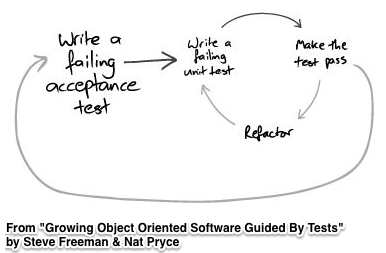This first appeared on my old blog in “2008 under the title Specification by Example”. I’ve made a couple of minor refinements to the text and I’ve added the image below from the 2009 “GOOS” book .
‘Internet radio‘ has come a long way since it first began. Long gone are the days where you have to seek out an online station that streamed a preselected playlist with mostly music that you like, or several stations for those with more eclectic taste. Instead, services like Pandora.com and Last.fm create a personalised radio station that matches the user’s own personal taste.
These personalised internet-radio stations are far more sophisticated than just specifying what genres and styles you like. When they first started you didn’t do that at all. When last.fm first started you provided an example of a song that you like. Software analysed the song finding common aspects of the music’s ‘DNA’ – including genre, tempo, how melodic it is and countless other sound characteristics in their database. From this they create a user-specific internet radio station that matches the users taste. As you listen, you give them feedback saying which songs you love and which ones you hate. Your future play-lists are refined with each piece of feedback you provide. This feedback is in itself more examples of songs that do and don’t match your taste. As a result you’d find yourself listening to songs you’d not have otherwise discovered.
That is Specification by Example! The product (in the above, your personal playlist) evolves by inferring the desired rules and characteristics from concrete examples.
And, as several have been saying for years… Test Driven Development is just that – Specification by Example – applied to software development. Instead of examples of songs, we provide examples of what we’d like the product, or part thereof, to do. These examples take the form of tests. It so happens that the evolution of the software product is performed by humans, unlike the internet playlist evolved by a machine.
